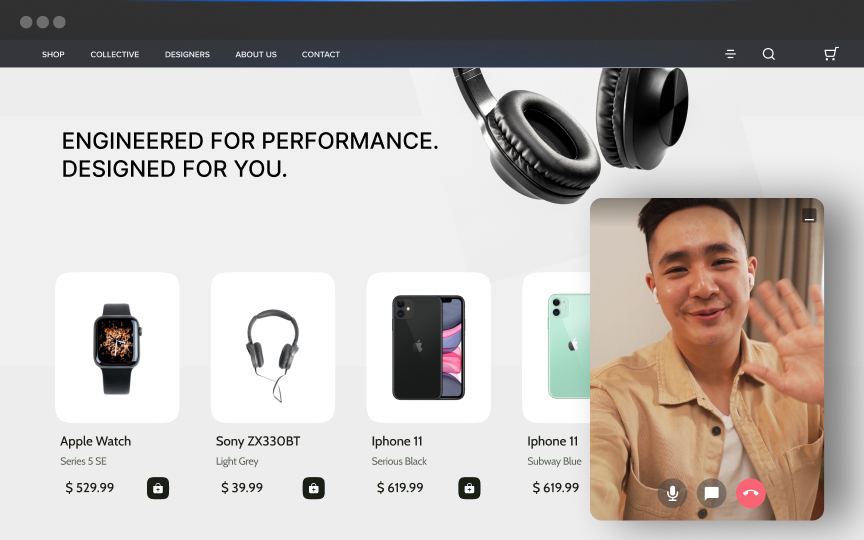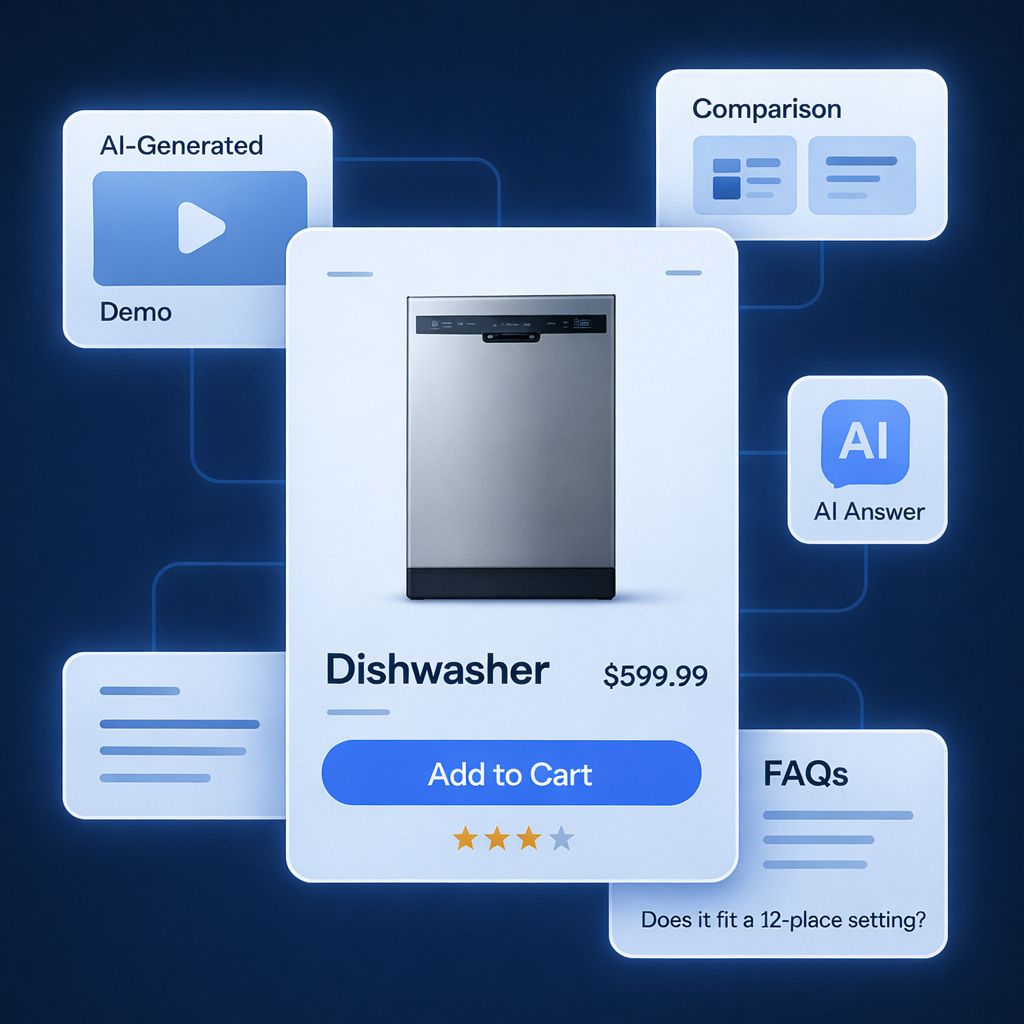In today’s competitive digital marketplace, understanding and selecting the right ecommerce platform is crucial for online success. This guide offers insight into what is an ecommerce platform and gives 7 strategies to help you to boost growth and customer engagement.
What Is An Ecommerce Platform?
An ecommerce platform is a software solution that allows businesses to manage and operate their online stores. It provides essential features like product listing, shopping cart functionality, payment processing, and order management.Ecommerce platforms streamline selling, enabling businesses to offer seamless, secure, and scalable online shopping experiences.
Types of Ecommerce Platforms
Understanding ecommerce platform types helps you choose the right solution for your business.
Software as a Service (SaaS)
SaaS platforms like Shopify and BigCommerce are cloud-based solutions with ready-to-use functionalities. They offer automatic updates, scalability, and app integrations. SaaS is ideal for businesses wanting fast deployment without managing server infrastructure.
Platform as a Service (PaaS)
PaaS offers more flexibility, allowing developers to build and deploy applications. Though less common in ecommerce, PaaS suits businesses needing tailored solutions and full control over their development environment.
- Customization: Build unique features tailored to your needs.
- Scalability: Easily adjust to business growth.
- Full Control: Maintain flexibility over development.
On-Premise Platforms
On-premise ecommerce platforms offer full control over hosting, security, and customization. Businesses are responsible for managing infrastructure, which allows for tailored solutions but requires significant technical resources and maintenance efforts. This option is ideal for enterprises needing full data control and highly customized functionalities.
Open-Source Platforms
Open-source ecommerce platforms like Magento and WooCommerce provide flexibility by granting access to source code. Businesses can customize every aspect of the store, but they must manage hosting, security, and updates. This solution is best for companies with technical expertise seeking high control and scalability.
Key Features of Ecommerce Platforms
Key features support your ecommerce business and enhance its operations.
Product Management Tools
Ecommerce platforms provide robust product management tools to help businesses manage their inventory. These tools enable the easy addition, updating, and organization of products, including categories, descriptions, images, and pricing. Efficient product management ensures an updated, accurate online store, enhancing the customer shopping experience and simplifying inventory control.
Mobile Optimization
Mobile-optimized ecommerce platforms ensure seamless shopping experiences across devices. With increasing mobile shopping, platforms need to deliver responsive designs that adjust to various screen sizes. Mobile optimization improves site speed, usability, and navigation, which leads to better customer satisfaction, increased engagement, and higher mobile conversions.
SEO and Marketing Integration
An integrated SEO and marketing toolset is essential for driving traffic to your ecommerce site. These features allow businesses to optimize product listings, create targeted promotions, and monitor marketing performance. Built-in SEO tools ensure higher search engine rankings, while marketing integrations help boost visibility through campaigns and promotions.
Shopping Cart Functionality
A user-friendly shopping cart guides customers from product selection to checkout. It allows them to add or remove items, view costs, and apply discounts. A smooth cart experience reduces abandonment and improves conversions.
Payment Processing
Secure payment gateways allow customers to complete transactions safely. Offering multiple payment options like credit cards, PayPal, and digital wallets increases convenience. Integrating reliable gateways ensures seamless and secure payments.
- Multiple Payment Options: Provide diverse ways to pay.
- Secure Gateways: Protect customer information.
- Smooth Checkout: Ensure hassle-free payment processes.
Other Important Features
Other important features include:
- Inventory Management: Track stock levels and receive notifications for low inventory.
- Customer Reviews: Enable reviews to build trust and influence purchasing decisions.
- Order Management: Manage orders efficiently from purchase to fulfillment.
- Analytics and Reporting: Access detailed reports on sales, traffic, and customer behavior.
- Shipping Options: Offer multiple shipping methods and real-time tracking for customer convenience.
- Customer Support Tools: Provide chatbots, FAQs, and support tickets for better customer service.
Examples of Popular Ecommerce Platforms
Popular platforms like Shopify, WooCommerce, and Magento cater to different business needs. Businesses can leverage these platforms to enhance marketing with video and engage customers more effectively.
Shopify
Shopify is a cloud-based SaaS platform with pre-built themes, an app marketplace, and automatic updates. It simplifies store setup and management, making it ideal for businesses that want an easy-to-use, all-in-one solution.
WooCommerce
WooCommerce is an open-source WordPress plugin offering high customization. It requires technical knowledge to manage hosting and maintenance but provides flexibility for businesses familiar with WordPress.
- Customizable: Tailor the store to fit your brand’s needs.
- Open-Source: Modify features with developer access.
- WordPress Integration: Leverage WordPress functionalities.
Magento
Magento is an open-source ecommerce platform known for its flexibility and scalability. It caters to medium to large businesses that need a highly customizable solution. With robust features like advanced SEO, inventory management, and support for multiple languages and currencies, Magento is ideal for businesses looking to scale globally.
BigCommerce
BigCommerce is a fully-hosted ecommerce platform known for its scalability and advanced marketing tools. It provides built-in features like SEO optimization, multi-channel selling, and robust analytics. BigCommerce is ideal for growing businesses looking to manage their store without extensive technical knowledge while benefiting from powerful tools to drive growth.
Squarespace
Squarespace is a user-friendly website builder with built-in ecommerce capabilities. It offers visually stunning templates, making it ideal for creative professionals and small businesses. While not as feature-rich as other platforms, Squarespace excels in ease of use, design flexibility, and simplicity, making it perfect for businesses focused on aesthetics.
Benefits of Ecommerce Platforms
Ecommerce platforms offer advantages that streamline operations and improve customer experience.
Convenience for Customers
Ecommerce platforms create an efficient, 24/7 online shopping experience. Mobile optimization, simple checkout, and accessible features boost customer satisfaction. Providing ease of use encourages repeat business and builds long-term loyalty. Additionally, strategies like community building with video commerce can further enhance customer engagement and loyalty.
Access to Global Markets
Ecommerce platforms allow businesses to sell internationally, removing geographical barriers. Global reach opens new customer segments, increasing revenue opportunities and allowing businesses to scale effectively.
- Sell Internationally: Expand your customer base worldwide.
- Multiple Currencies: Offer payment in various currencies.
- Global Shipping: Provide shipping options to different regions.
By leveraging these advantages, businesses can enhance the brand experience, fostering stronger customer relationships.
Cost Efficiency
Ecommerce platforms reduce operational costs by minimizing the need for physical storefronts and staff. They automate tasks like inventory management, customer service, and payment processing, allowing businesses to operate more efficiently. By saving on overhead costs, businesses can allocate more resources to marketing and product development.
Personalized Shopping Experience
Advanced ecommerce platforms use data and AI to deliver personalized experiences. By analyzing customer behavior, platforms can offer tailored product recommendations, dynamic pricing, and personalized promotions. This level of customization enhances customer engagement, increases conversion rates, and fosters brand loyalty by addressing individual needs.
Scalability
Ecommerce platforms provide scalability to businesses, allowing them to grow without major infrastructure investments. As the business expands, the platform can handle increased traffic, higher order volumes, and more products without sacrificing performance. This flexibility supports business growth and ensures smooth operations even during peak times.
Other Benefits
Other benefits include:
- Analytics and Insights: Gain valuable data on customer behavior, sales trends, and marketing performance.
- Omnichannel Support: Seamlessly integrate with physical stores and other sales channels for a unified experience.
- Automated Marketing: Use email campaigns, retargeting ads, and abandoned cart recovery tools to boost sales.
- Social Media Integration: Sell products directly through social media platforms and leverage social commerce.
- Secure Data Management: Ensure secure transactions and compliance with privacy regulations.
Strategy 1: Use Data Analytics
Data analytics helps optimize ecommerce platforms for better user experiences and sales.
Track User Behavior
Analyzing how customers interact with your site provides insights into their preferences. By leveraging first-party data, you can tailor product recommendations, improve navigation, and enhance the overall shopping experience, potentially incorporating AI-generated videos to engage customers.
Monitor Sales Performance
Sales analytics identify trends and opportunities for improvement. Adjust pricing, optimize inventory, and launch targeted promotions based on insights from your sales data. Additionally, using video content creation tools can enhance your marketing efforts by producing content that resonates with your audience.
- Analyze Trends: Understand customer behavior and preferences.
- Optimize Promotions: Tailor campaigns based on data insights.
- Adjust Pricing: Respond to trends with pricing strategies.
Strategy 2: Optimize for Mobile Users
Mobile optimization is key for increasing conversions and enhancing customer experience.
Ensure Responsive Design
Responsive design ensures your site works smoothly across various devices, providing a consistent user experience. Many ecommerce platforms offer mobile-optimized templates that enhance navigation and performance on smartphones.
- Responsive Layouts: Adapt to different screen sizes.
- Mobile Optimization: Improve speed and navigation for mobile users.
- Mobile Checkout: Simplify payment processes on smaller screens.
Test Mobile Performance
Regularly test your ecommerce site’s performance on mobile devices. Check load times, responsiveness, and ease of navigation to identify any issues. A well-optimized mobile experience ensures that customers can browse and purchase seamlessly, no matter the device.
Streamline Mobile Checkout
Ensure the mobile checkout process is fast, simple, and secure. Reducing friction at this stage can help minimize cart abandonment and boost sale
Strategy 3: Implement Customer Support Solutions
Strong customer support solutions improve satisfaction and encourage repeat business.
Multi-Channel Support
Offering chat, email, and phone support integrates multiple communication channels, ensuring customers can reach you easily. Centralized support tools streamline interactions and provide quick resolutions, boosting customer satisfaction.
Personalization in Customer Service
Personalized customer service using unified profiles improves interactions. Utilizing methods such as personalized engagement with interactive video and access to previous purchase history and communication helps tailor responses, building trust and fostering loyalty.
- Unified Profiles: Access customer data for personalized service.
- Multi-Channel Tools: Centralize customer interactions.
- Efficient Responses: Resolve queries quickly and effectively.
Strategy 4: Leverage Omnichannel Selling
Omnichannel selling involves integrating your ecommerce platform with multiple sales channels to offer a seamless shopping experience.
Integrate with Social Media
Connecting your ecommerce store with social media platforms like Facebook, Instagram, and Pinterest allows customers to shop directly from your social media pages. This approach increases visibility, engagement, and sales by making the purchasing process more convenient for social media users.
Synchronize Inventory Across Channels
Ensure that your inventory is synchronized across all sales channels, including your website, physical stores, and social media platforms. This prevents overselling and improves the customer experience by providing accurate stock information in real-time.
Strategy 5: Automate Marketing Campaigns
Automating marketing efforts can streamline customer engagement and increase conversions.
Email Marketing Automation
Email automation allows you to send personalized messages based on customer behavior. Automated emails, such as abandoned cart reminders, welcome messages, and product recommendations, help engage customers and drive conversions without manual effort.
- Abandoned Cart Emails: Recover lost sales with automated reminders.
- Personalized Emails: Tailor messages based on user behavior.
Retargeting Ads
Retargeting ads help re-engage visitors who have left your site without making a purchase. By displaying personalized ads on other websites or social media, you can remind potential customers of products they viewed, encouraging them to return and complete their purchase.
- Behavioral Retargeting: Target customers based on past interactions.
- Increase Conversions: Bring back potential customers with personalized ads.
Strategy 6: Enhance Security Measures
Ensuring that your ecommerce platform is secure is critical for building trust with customers and protecting their data.
Implement SSL Certificates
SSL certificates encrypt sensitive customer information, ensuring that transactions are secure. Displaying the SSL padlock symbol on your site builds trust with customers and reassures them that their data is protected during the checkout process.
- SSL Encryption: Secure data transmission between customers and your site.
- Build Trust: Reassure customers with visible security measures.
Utilize Two-Factor Authentication (2FA)
Two-factor authentication adds an extra layer of security for user accounts by requiring both a password and a second verification method, such as a code sent to their phone. This reduces the risk of unauthorized access and helps protect customer accounts.
- Extra Security: Require multiple verification methods for login.
- Prevent Fraud: Safeguard accounts from unauthorized access.
Strategy 7: Stay Updated with Industry Trends
Staying competitive requires monitoring ecommerce trends and adopting new technologies.
Monitor Emerging Technologies
Integrating AI-powered ecommerce, augmented reality (AR), and virtual reality (VR) enhances the shopping experience by offering personalization and immersive engagement. Additionally, utilizing live shopping influencers can boost customer engagement and keep your business ahead of the trend.
Analyze Competitor Strategies
Monitoring competitor tactics allows you to identify what works and implement those strategies. Use data analytics to refine your approach and differentiate your business in a competitive market.
- Adopt AI Tools: Personalize customer interactions with automation.
- Explore AR/VR: Offer virtual product try-ons or previews.
- Track Competitors: Learn from successful tactics in your niche.
Conclusion
By understanding these essential insights into ecommerce platforms, you're now equipped to choose and implement a solution that aligns with your business goals and enhances your online presence. With the right platform and features, you can improve customer experiences and position your business for sustained growth.
Unlock Exclusive Insights
By submitting this form, you agree to Firework's privacy policy and consent to receive personalized marketing communications. You can unsubscribe at any time.




























